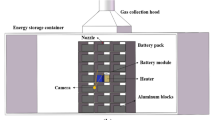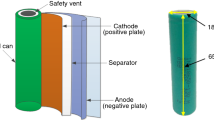Abstract
The hybrid type electric multiple units (EMUs) are generally equipped with LiCoO2/Li4Ti5O12 lithium-titanate (LTO) batteries. LTO batteries are often in a state of high-rate charging and discharging since they are mainly used for emergency traction and braking recycling of EMUs. Under such operating conditions, LTO batteries have a higher risk of thermal runaway, which would induce battery fires in the operation and lead to grave consequences. In this paper, a fire suppression device containing a fire detection tube was proposed for the power battery system of hybrid EMUs. Meanwhile, experiments were conducted to detect thermal runaway of the single battery and thermal expansion of the battery module installed with the fire suppression device. The fire detection tube was filled with clean agent Dodecafluoro-2-methylpentan-3-one. During the experiment, when triggering the process of thermal runaway, the fire suppression device prevented the battery from catching on fire successfully. Moreover, the fire suppression device had good cooling performance. The thermal runaway temperature of the battery with the fire suppression device installed was lowered to 130°C or so, compared with 550°C of the single battery alone. The fire suppression device was then installed in the battery system of a hybrid EMU, which performed well in operation.
















Similar content being viewed by others
References
Tian R, Kang Y (2012) Development of hybrid electric locomotive at home and abroad. Diesel Locomot 10:1–4
Wang W, Ruan H (2014) Research and development of CFH330 narrow gauge petrol-electric hybrid locomotive. Railw Locomot Bull Train 11:14–16
Zhang X, Tian Y, Zhang X (2012) Research on power system modeling and energy management of hybrid electric locomotive. J China Railw Soc 34:20–25
Tian R, Kang Y (2012) Development of hybrid electric locomotive at home and abroad. Diesel Locomot 9:1–4
Li X, Wang Z, Ma Z (2013) Battery system design of dual power EMUS based on lithium ion battery. China Railw 7:73–77
Ramadass P (2003) Capacity fade analysis of commercial Li-ion batteries. Dissertation, University of South Carolina
Zhang S, Xu K et al (2006) Charge characteristics of a commercial LICoo2-based 18650 battery. J Power Sources 160:1403–1409
Zheng X (2007) Lithium-ion battery electrolyte. Chemical Industry Press, Beijing
Wang Z, Gong M (2011) Lithium titanate battery management system for EMU. China Railw 12:64–66
Wu J (2015) Simulation platform for hybrid electric EmU power integration scheme design and evaluation. Dissertation, Southwest Jiaotong University
Feng X, He X, Ouyang M, Lu L, Wu P, Kulp C et al (2015) Thermal runaway propagation model for designing a safer battery pack with 25Ah LiNixCoyMnzO2 large format lithium ion battery. Appl Energy 154:74–91
Liu P, Li Y, Mao B, Chen M, Huang Z, Wang Q (2021) Experimental study on thermal runaway and fire behaviors of large format lithium iron phosphate battery. Appl Therm Eng 192:116949
Mao B, Liu C, Yang K, Li S, Liu P, Zhang M et al (2021) Thermal runaway and fire behaviors of a 300 Ah lithium ion battery with LiFePO4 as cathode. Renew Sustain Energy Rev 139:110717
Ren D, Feng X, Liu L, Hsu H, Lu L, Wang L et al (2021) Investigating the relationship between internal short circuit and thermal runaway of lithium-ion batteries under thermal abuse condition. Energy Storage Mater 34:563–573
Plunkett ST, Chen C, Rojaee R, Doherty P, Sik OhY, Galazutdinova Y et al (2021) Enhancing thermal safety in lithium-ion battery packs through parallel cell ‘current dumping’ mitigation. Appl Energy 286:116495
Richter M, Sarram A, Kaucher C, Winkler H (2019) Investigation and analysis of accumulators for the use of electrochemical storage in hybrid shunting locomotives. Procedia CIRP 81:1010–1015
Egelhaaf M, Kress D, Wolpert D et al (2013) Fire fighting of Li-ion traction batteries. SAE Int J Altern Powertrains 2:37–48
Liu Y, Duan Q, Xu J et al (2018) Experimental study on the efficiency of dodecafluoro-2-methylpentan-3-one on suppressing lithium-ion battery fires. RSC Adv 8:42223–42232
Liu T, Tao C, Wang X (2020) Cooling control effect of water mist on thermal runaway propagation in lithium ion battery modules. Appl Energy 267:115087
Liu Y, Duan Q, Xu J et al (2020) Experimental study on a novel safety strategy of lithium-ion battery integrating fire suppression and rapid cooling. J Energy Storage 28:101185
Zhang L, Li Y, Duan Q et al (2020) Experimental study on the synergistic effect of gas extinguishing agents and water mist on suppressing lithium-ion battery fires. J Energy Storage 32:101801
Wang H, Tang A, Wang K (2011) Thermal behavior investigation of LiNi1/3Co1/3Mn1/3O2-based Li-ion battery under overcharged test. Chin J Chem 29:27–32
Du Pasquier A, Disma F, Bowmer T, Gozdz AS, Amatucci G, Tarascon JM (1998) Differential scanning calorimetry study of the reactivity of carbon anodes in plastic Li-ion batteries. J Electrochem Soc 145:472–477
Shin J, Han C, Jung U, Lee S, Kim H, Kim K (2002) Effect of Li2CO3 additive on gas generation in lithium-ion batteries. J Power Sources 109:47–52
Acknowledgements
This work is supported by the Key Science and Technology R&D Project of Dalian China (No.2020YF18GX006) , the Major Science and Technology Research Project of CRRC Corporation Limited (No.2019CKZ205) and the Fundamental Research Funds for the Central Universities (No.WK5290000003).
Author information
Authors and Affiliations
Corresponding authors
Additional information
Publisher's Note
Springer Nature remains neutral with regard to jurisdictional claims in published maps and institutional affiliations.
Rights and permissions
Springer Nature or its licensor (e.g. a society or other partner) holds exclusive rights to this article under a publishing agreement with the author(s) or other rightsholder(s); author self-archiving of the accepted manuscript version of this article is solely governed by the terms of such publishing agreement and applicable law.
About this article
Cite this article
Li, Z., Fu, Y., Liu, A. et al. An Experimental Study on Fire Suppression Devices for Power Batteries of Hybrid Electric Multiple Units. Fire Technol 59, 1303–1318 (2023). https://doi.org/10.1007/s10694-022-01351-x
Received:
Accepted:
Published:
Issue Date:
DOI: https://doi.org/10.1007/s10694-022-01351-x




